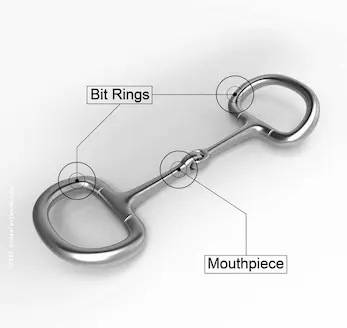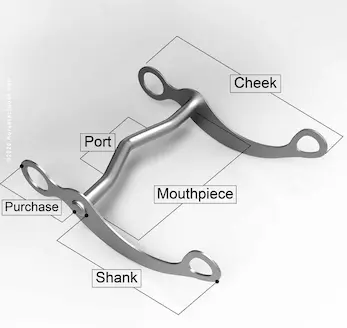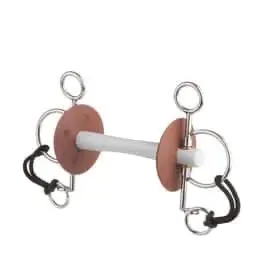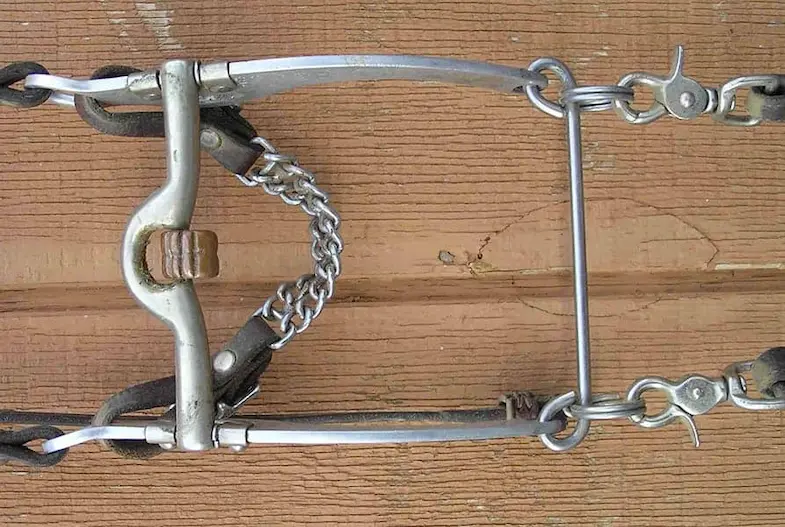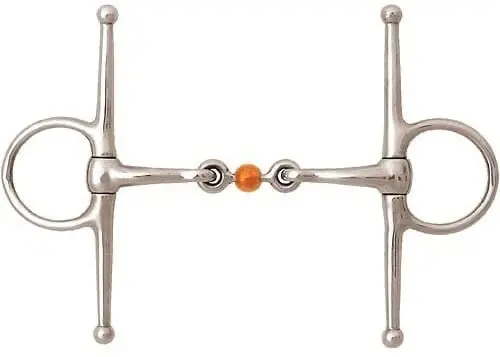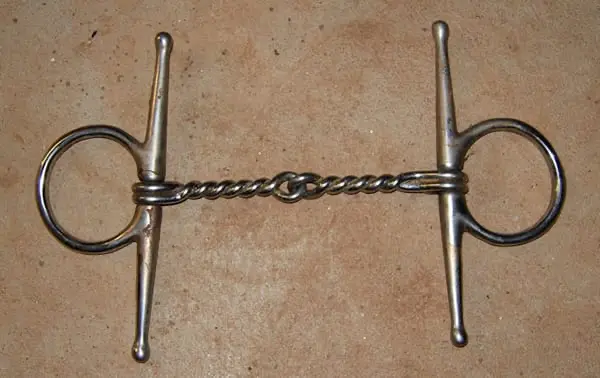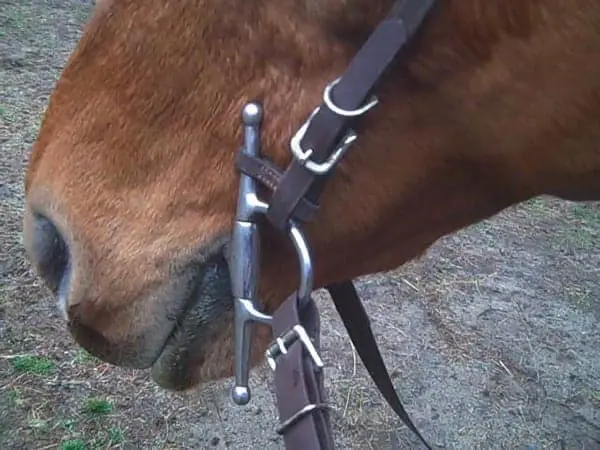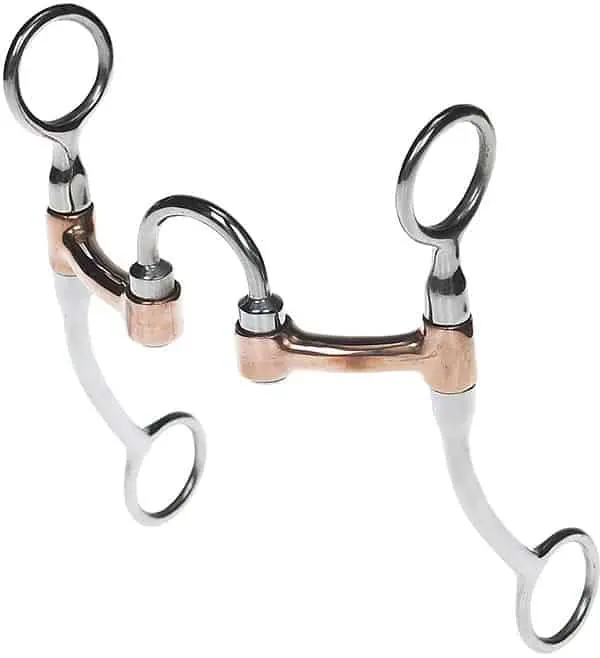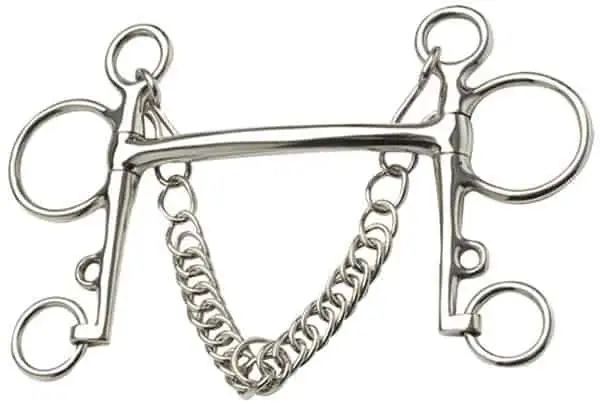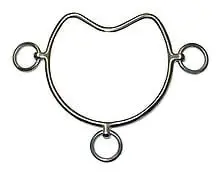The world of horse bits can often seem like something of a black art, and with so many different bits and mouthpieces on the market, it can be easy to see why. Then there are the different types of riding, how can both English and Western have so many different types of bit? When you consider that the bit, in most cases at least, sits inside the horse’s mouth it’s important to get the right one. This is why I wanted to write this article, to help explain some of the mysteries surrounding them.
What is the purpose of a horse bit?
Contrary to popular belief the bit isn’t designed to actually control the horse, it is, in the simplest of terms designed to communicate the rider’s wishes to the horse. The idea is that the bit applies subtle pressure to the bars of the mouth which are made of sensitive cartilage. The horse is responsive to any movement or pressure on those bars and instinctively moves away from it, which means that they actually move in the direction the rider wants them to go.
The bit works with the reins to apply this pressure but in the case of curb bits, it can also work with the bridle to exert additional pressure on various parts of the horse’s head such as the cheeks, chin, and nose. This additional pressure can either be used to back up that created by the bit or instead of it.
To sum its purpose up in just one sentence, the bit is an aid used by the rider to communicate with the horse.
What are the different parts of a bit?
A snaffle bit which is the most common English bit, in most cases, comprises of just two parts, the mouthpiece, which as you’d expect goes in the horse’s mouth, and the bit rings that the bridle and reins are attached to.
Curb (or leverage) bits on the other hand are slightly different. They still have a mouthpiece but instead of the bit rings, they have cheeks. These cheeks include the shank which is below the mouthpiece and the purchase which is above it. The purchase is fixed to the bridle and can be short or long, a short purchase will move much quicker in the horse’s mouth whereas a long purchase will be much slower. The shank, on the other hand, is what gives the leverage and again can be short or long with shorter shanks giving the riderless control and the longer shank giving them more control. Curb bits can also be used with or without a curb chain or strap that attaches to the top of the purchase, this helps to reduce the pressure that is applied to the horse’s poll.
Does the bit hurt a horse’s mouth?
The idea of the bit is to apply pressure to the horse’s mouth and or tongue but that doesn’t necessarily mean that it will hurt the horse. Of course in the wrong hands, even the mildest of bits will hurt the horse but when used properly and with consideration then no a bit won’t hurt a horse’s mouth at all. The mouth of some horses will be more sensitive than others so it’s always better to use the ‘kindest’ bit you can.
It’s always important to use the right bit and mouthpiece for the job, after all, you should never use a curb bit with a specialist mouthpiece such as a spade-shaped port as a correction bit. Instead, it’s far better to start with a milder bit and then change it if you find that isn’t strong enough.
How do you measure your horse for a bit?
It’s vitally important that you get the right sort of bit for your horse because if the bit is too small then it’ll pinch your horse’s mouth but conversely if it’s too large it won’t stay in place and is likely to rub against the teeth and damage them.
There are a number of different ways to measure a horse’s mouth for a bit and in an ideal world you’d use an old one as a size guide but if this isn’t possible then you can use a bit sizer. This is a plastic shank with a stopper on one end, the idea is that you put it in your horse’s mouth with the stopper positioned against his cheek. Once you’ve done that you can simply look at the other side to get the measurement for your horse’s mouth.
If you don’t have a bit sizer then you can use something like a piece of string or wooden dowel as a guide. Simply put it in your horse’s mouth and use a pen to mark either side of his mouth and then measure that.
Alternatively, if you’re intending to measure a lot of horses then you might want to consider investing in a set of calipers. These are quite expensive allow but you to quickly measure any horse by opening the arms and placing them on either side of your horse’s mouth.
While it’s important to have the correct sized bit you might not be able to find the exact right size for your horse. If this is the case though don’t worry, it’s better to go for a bit that is slightly too big and then use bit guards (or cheek guards). These rubber guards are soft, flexible disks that fit on the end of the mouthpiece and are designed to act as stoppers to prevent the bit from pinching the horse’s mouth and also to stop the bit from being pulled through the horse’s mouth.
Do all horse bits have the same mouthpiece?
The mouthpiece, which is common to both snaffle and curb bits, can vary greatly in the material it’s made from as well as its physical appearance. It’s made up of a bar that comes in a number of forms and can be a straight bar (with or without an inverted u shape known as a port), two bars (that are either linked to each other or to a connecting link or ring) or in some cases it can be a chain. Then there’s what the bar is made from, some bars will be plain pieces of metal while others will have alternating ‘rollers’ made of stainless steel and copper, but not all bars are made of metal. Some have been designed for horses that are bit shy or have very sensitive mouths and these can be made from vulcanized rubber (that has been baked onto the metal mouthpiece), high-tech plastic that has a strong apple scent or ‘sweet iron’ which is mild or carbon steel.
As well as communicating the rider’s wishes to the horse the mouthpiece is also designed to encourage the horse to salivate which is why it’s made from different materials, some will promote the production of saliva more than others and not all horses need much encouragement.
On top of the different bars and materials, there’s also a wide selection of mouthpieces too, each with its own uses.
- Mullen Mouth – The mullen mouth is a single bar mouthpiece that is thought to be kinder than jointed mouthpieces because there’s no pinching at all. A mullen mouth can be made of any number of materials but high-tech plastic or vulcanized rubber are by far the most common.
- Jointed – Most mouthpieces are either mullen or jointed which applies to those that comprise of two or more bars. The bars can either be single-jointed or double-jointed.
- Single – Probably the most common type of jointed mouthpiece, they are joined together in the center. One of the disadvantages of the single-jointed mouthpiece though is that they often create a nutcracker effect when the rider applies pressure to the reins. This can sometimes pinch the horse.
- Double – As you’d expect a double-jointed mouthpiece has two bars that are joined to a centerpiece that can be a link, port, roller, or a variety of other shapes. The nutcracker effect that’s often experienced with a single-jointed mouthpiece is minimized.
- Port – These mouthpieces have an upward curve (or inverted U shape) in the middle that reduces the pressure on the horse’s tongue, this means that the horse isn’t able to use his tongue to lessen the effect of the bit. The port comes in a range of styles and can be low (less than 1 inch), medium (1 to 2 inches), or high (2 inches and above).
- Ported Link – A ported link mouthpiece, which is sometimes called a double-joint port, has a center port that is linked on both sides to the bar.
- Cathedral – A cathedral port is a high port that has been flattened, it’s used for a range of western disciplines but should only be used by experienced riders on horses that have been well trained. It also has a curb chain that works to soften the pressure on the horse.
- Spade – Originating from the vaquero (Spanish and Mexican cattle drivers), this port has a ‘shape’ like appearance that has a copper roller in the center. The spade is considered a strong bit that should only ever be used by experienced riders on horses that have been highly trained. In inexperienced hands, it can hurt the horse.
- Spoon – Having a flattened media or high port, the spoon is gentler on the horse’s mouth when compared to unflattened high port bars. Its commonly used on highly trained horses for advanced maneuvres when working cattle.
- Rollers – A roller mouthpiece consists of rollers or barrels that are made of copper and or stainless steel or sweet iron. The idea of a roller mouthpiece is to encourage the horse to salivate which makes the bit more responsive. There are a number of different roller mouthpieces:
- Single roller – A single roller mouthpiece, as you would expect, has just one roller in the center of the bar. This roller can be thick or thin but is generally made of copper.
- Alternating (or multiple rollers) – Similar to the single roller in that the rollers are in the middle of the bar but with this mouthpiece the rollers alternate between copper and stainless steel or sweet iron.
- Crickets – This involves a single roller in the middle of a medium or high port, the name ‘cricket’ comes from the noise that the bit makes when it’s rolled.
- Billy Allens – Named after a Kansas horseman, this mouthpiece (which is made up of three individual pieces) is a jointed piece with a single roller in the middle. Its most commonly used in training colts that are moving on from a snaffle bridle.
- Broken Segunda – This is the opposite of a high port mouthpiece because the curve bends downwards instead. It’s mainly used by experienced riders on horses that are very strong.
- Center Link – A center link mouthpiece is a three-piece, double-linked mouthpiece that has a center link in a variety of different shapes (the centerpiece can also be a roller). The mouthpiece itself gives the rider more control.
- French – The French link has a peanut-shaped center link.
- Oval Mouth – Also known as a lozenge mouth, this has a rounded ‘lozenge’ shaped center link.
- Ball – Instead of the center link being a peanut or lozenge shape it’s a ball that is often made of copper. Considered harsher than the French link due to the fact that the ball applies the pressure in one place.
- Dr. Bristol – The center link of a Dr. Bristol (or Doc Bristol) is similar to the oval mouth but is longer and flatter which means that it puts more pressure on the horse’s tongue. The flat edges of the Dr. Bristol make this mouthpiece relatively harsh.
- Lifesaver – Taking its name from the center ‘O’ ring that looks like a lifesaver, it’s often used as a transition bit for horses and, like other link mouthpieces, applies pressure on the tongue.
- Dogbone – Like the lifesaver, it takes its name from the appearance of the center link, the dogbone often has a roller (or multiple rollers) on it.
- Moon – Available as a quarter or half-moon, the ‘moon’ piece allows the horse to move his tongue and as such is softer than the French link.
- Keys – This refers to the ‘keys’ which can either be attached to a center ring or a roller-type attachment to a mullen mouthpiece. Mainly used to train young horses, the keys give the horse something to play with and encourage him to accept the bit.
- Waterford – Looking like a ball and chain link, the Waterford can be anything from 5 to 9 links and is extremely flexible which means the horse can’t lean on it. Popular with show jumpers, a lot of horses find the Waterford very comfortable due to the fact that it’s loose in their mouth and doesn’t apply unnecessary pressure.
- Double mouth – Unlike most other mouthpieces, the double mouth (or W or Y as it’s also known) has two mouthpieces that can either be straight or jointed. Sometimes called a scissor bit, this is an extremely harsh bit because the double mouthpiece intensifies the nutcracker effect. It, therefore, should only ever be used by experienced riders on horses that are very strong and don’t respond to other bits.
- Twisted – Twisted mouthpieces can be mullen mouthed or jointed and are considered to be amongst the most severe of mouthpieces although the number of turns or twists will determine the severity. A slow twist has few turns and is the least severe with a fast twist being the harsher.
- Wire – This is similar to the twisted mouthpiece but is thinner which makes them even more severe. The thinness of the wire focuses all of the pressure on the horse’s mouth which is why many people consider them to border on cruelty.
- Chain – Thankfully the chain, which is extremely severe, isn’t so common these days and its use is widely frowned upon. It’s made for a number of links and often looks like a bicycle chain.
- Hollow – Due to their hollow nature these mouthpieces are extremely light and, while they’re not suitable for every horse, they are considered to be much kinder than most other mouthpieces due to the fact that the pressure is applied over a wider area.
What are the different types of bits?
As well as various different mouthpieces there’s also a huge selection of different bits that, with the exception of one or two, fall into one of a few different categories:
Snaffle bits
A snaffle bit is probably the most popular bit in the world, regardless of discipline. It’s more common in English riding but its gentle nature makes it a great choice for inexperienced horses and riders. The definition of a snaffle is a simple bit that has one set of reins and therefore only applies pressure to the horse’s mouth. It’s believed that the word snaffle is derived from the mid-16th century German or Dutch word, snavel, which means beak or mouth.
Snaffles normally have either a straight mouthpiece or are single jointed and can have a variety of different ring styles, each with its own purpose, some of the most common ones are:
- Eggbutt – When asked to describe a bit most people will probably think about the eggbutt snaffle and with good reason. It’s the mildest of all snaffles and, due to the way the rings are attached it’s unlikely to pinch the horse’s mouth.
- D-ring – So called because of the D-shaped rings that the reins attach to, like the eggbutt, this bit is very gentle and unlikely to pinch. Some people prefer the styling of the D-ring.
- Loose ring – As you can probably tell by its name, the rings aren’t fixed to the mouthpiece and can move freely. The loose ring bit is extremely gentle but some horses find that, because the rings aren’t fixed they can pinch the side of the mouth a little. If you find this to be the case though you can use bit guards to stop this.
- Full Cheek – The appearance of the full cheek is similar to D-ring except the ‘rings’ are smaller and also have ‘cheeks’ that extrude from the points of the ring. This is designed to stop the bit from being pulled through the horse’s mouth. The top of the cheeks can be fixed to the bridle but this gives the bit a slight curb action as it also pulls on the poll a little.
- Hanging Cheek – Similar to the eggbutt, the hanging cheek has a cheekpiece that’s fixed to the bridle while the reins are attached to the cheek. Some people say that a hanging cheek bit puts pressure on the poll but, certainly in my case, I’ve never found that to happen.
- Bradoon – Typically the bradoon is either an eggbutt or loose ring snaffle bit, what makes the bradoon different though is that it was developed to be used as a combination bit with a curb bit.
Curb bits
Also known as a leverage bit because the arms (or shanks) pull against the curb chain (or strap) and bridle to not only apply pressure to the horse’s mouth but also to the poll, checks, and chin. The cheek pieces of many curb bits will also be highly decorative which doesn’t affect the way the bit works but does look nice.
- Western Grazing – Like the eggbutt snaffle, the western grazing bit is one of the most common of all western bits. It takes its name from the fact that the shanks were originally angled backward so that the horse could continue to graze with the bit still in his mouth.
- Tom Thumb – Most curb bits come with a straight or ported mouthpiece but the Tom Thumb has a single jointed mouthpiece which often leads to it mistakenly lead to it being classed as a snaffle. It’s often used in the show ring but is also a popular choice for trail riding.
- Western S-Shank Curb – As you can probably tell this bit has an ‘S’ shaped shank which is where it gets its name. It also has a high port mouthpiece that can be either copper or stainless steel.
- Western Correction – Contrary to the name, this is not actually a correction bit but instead should only be used on horses that have been well trained. The ‘correction’ term comes from the fact that it’s often used to enhance a horse’s response to the reins.
- Gag – There are a variety of different gag bits but they generally are all used for horses that have a strong pull. They’re not allowed at dressage competitions but are common on polo ponies or eventing horses.
- Gag snaffle – Despite being a curb bit, the gag snaffle looks a little bit like a snaffle bit with a ring attached to either side of the mouthpiece. The cheekpiece on a gag snaffle has two holes (one at each end) with a rope or leather cord running through them that the reins are also attached to. There are two different gag snaffles, the Cheltenham gag which has an eggbutt ring, and the balding gag which has a loose ring.
- Continental – Also called a Dutch gag or Pessoa gag has a main ring in the cheekpiece that has a smaller ring for the bridle at the top and two smaller rings underneath for the reins which can be attached to either of the rings. The rider can choose which ring to attach the reins to which can act in the same way as the shank of a curb bit.
- Elevator – Sometimes called an American gag, this bit has a jointed mouthpiece that can move up and down the curved cheekpiece. The American gag is used for extra control but should only be used once all other options have been exhausted.
- Duncan – The Duncan, or half-ring as it’s also known is similar to the snaffle except for the fact that the ring isn’t closed (and is only half a ring) and has to be used with gag reins because there’s no way to attached regular reins.
Combination bits
Also known as double bridles, they are in reality two bits rather than two bridles (although the bridle will have two cheek straps) and are typically used with two sets of reins or a rein converter which means you only need one set of reins.
- Pelham – To some extent, the pelham isn’t a combination bit (because it is just one single bit) but I’ve included it here because it does require two sets of reins. It’s the most popular bit of this type and is found in both English and Western disciplines.
- Weymouth – A true combination bit, the Weymouth is commonly used with the bradoon. Its often used for dressage and requires a double bridle and two sets of reins.
- Kimberwick – Also known as a Kimblewick, it’s similar in appearance to the D-ring snaffle bit with a curb chain. The kimberwick, like the pelham, is technically a curb bit but it also acts like a snaffle, albeit with more ‘stopping power’!
In-hand bits
You might think that a bit is only for riding but there are also a number of bits designed specifically for horses that are being led in-hand and should never be used for riding.
- Chifney anti-rearing – The Chifney was designed for horses that are difficult to lead and as such as got a bit of a reputation for being severe, although any bit can be in the wrong hands. It works by applying downward pressure as the horse tries to pull away.
- Tattersall ring – Mainly used for leading young racehorses, it passes through the mouth and around the lower jaw.
- Horse-shoe stallion – Despite its name, this bit isn’t exclusively for stallions, although it was originally designed for them. It’s a mullen mouth bit with decorative horseshoe brass cheekpieces.
How to find the right bit for your horse
When it comes to choosing the right sort of bit for your horse there are a few things that you need to take into account before.
How experienced you are
You might not think that your level of experience will make a difference when selecting a bit but it actually makes a big difference. After all, the bit is your primary contact with the horse; as such, he’ll feel any movement you make with your hands, no matter how subtle. When you ride your hands will need to move independently from the rest of your body and it takes time to learn to keep your hands steady while riding. With this in mind, it’s important to consider how much your hands might move.
How sensitive your horse is
Some horses will have a very sensitive mouth while others will be classed as hard-mouthed which means that they hardly feel the bit which is why you need to take this into account when choosing a bit. A gentle eggbutt snaffle will have little effect on a horse with a hard mouth but conversely, a jointed bit may hurt a horse with a sensitive mouth.
How your horse has been trained
Some bits, such as those with a high port spade-shaped mouthpiece, require a horse to be specially trained to a certain level before they can even consider using this type of bit so you’re likely to do your horse’s mouth a lot of damage if you use something like this too soon.
On the other hand though if you’re intending to train your horse for a particular purpose or train him to correct a bad habit such as leaning on the bit (where the horse ‘rests’ his own weight on the bit and uses the rider for support and balance) then this will affect the style of bit you use.
Your chosen discipline
Many bits will be interchangeable with different disciplines so if you’re intending to just ride for fun then it doesn’t really matter what sort of bit you choose as long as you’ve taken the above into consideration. When it comes to competing or showing your horse though there are a lot of rules around the style of bit you can and can’t use. For example, something like a kimberwick isn’t allowed at dressage competitions but is perfectly acceptable at any field hunter class.
Conclusion
While some bits are more severe than others even the mildest bit will hurt the horse in the wrong hands so it’s crucial to get the right bit, not only for your horse’s strength and the level to which he’s trained but also for your level of experience too. And don’t forget that a bit is your primary contact with your horse so be gentle.
Most online saddleries have a wide selection of bits but I prefer to use horse.com because I find their collection of both Western and English very good.
Related question
Can you use the same bit for more than one horse?
There are two things to consider when using the same bit for multiple horses, the fit of the bit and any health issues the horse has. When it comes to the fit, it’s crucial that it’s right for both horses and doesn’t pinch at all. That said though if one of the horses has a contagious health issue they will pass it on to other horses using the same mouthpiece. With this in mind, you can use the same bit but it’s not advisable.
Further reading
- The Best Way To Clean Tack
- Are treeless saddles any good
- Am I Too Old To Ride?
- Where Should I Keep My Horse?
- Unusual Horse Sports
- Bandaging Your Horse’s Legs
- Want To Work With Horses?
- Life Hacks For Horse Owners
- What’s My Horse Thinking?
- Horse Insurance Explained
I hope you found this article helpful. If you did I’d be grateful if you could share it please as it would really help me.
Recommended products
Over the years I have tried hundreds of different horsey products, from various blankets and halters to different treats. Some I’ve loved, others I’ve hated but I thought I’d share with you my top all-time favorite products, the ones I never leave the yard without. I’ve included links to the products (which are in no particular order) that I really think are great.
- Horse Knots by Reference Ready – If you’re like me and enjoy pocket reference guides then you’ll love this knot tying guide. These handy cards can easily fit in your pocket or attach to the saddle for quick reference. They’re waterproof, durable and are color coded to make them easy to follow.
- Mane ’n Tail Detangler – Even if you never show your horse you’ll need to detangle his tail from time to time (and possibly his mane too) which is always a challenging chore! I’ve found that if I run a little bit of detangler through my horse’s tails every few days it stops them from getting matted up and makes combing them easy, even if they’re coated in mud. I don’t know if I should admit to this or not but it also works wonders on my hair.
- TAKEKIT Pro clippers – Over the years I’ve tried a lot of different clippers and while some were obviously better than others I found these to be by far the best. They are heavier than a lot of other clippers but for me, that’s a good thing, it makes them feel more sturdy and hardwearing. On top of that they have a range of speeds so are just as good for clipping your horse’s back as they are his face. I also like the fact that they come in a handy carry case but that’s not for everybody. The company that makes them is super good and incredibly helpful too, a real bonus these days. The only thing I wasn’t keen on was the fact that it doesn’t come with any oil, but that’s not a major problem as it’s not difficult to buy lubricant.
- Shire’s ball feeder – There are so many boredom buster toys out there but I like to use these every day, regardless of whether or not my horses are bored. I find that it helps to encourage my horses to problem solve by rewarding them with treats (or pieces of fruit) but it also mimics their natural grazing behavior which helps to keep them calm and de-stressed.
- Horse safe mirror – This is a strange one that many people are surprised about but I like to put horse safe mirrors in the trailers as well as in the quarantine stalls. It helps to prevent the feeling of isolation by giving the impression of other horses being around. Being herd animals horses can get extremely stressed when they feel that they’re on their own but with these stick-on mirrors, they believe that at least one other horse is with them.
- Rectal thermometer – I know this isn’t glamourous at all but it’s vital for your horse’s well-being to be able to check their temperature and a rectal thermometer is the easiest way of doing this which is why I’ve added it to the list.
Shopping lists
I’ve also put together a few shopping lists of essential items that I’ve found helpful over the years. I’ve broken the lists down into different categories rather than put everything in one massive list 😉

